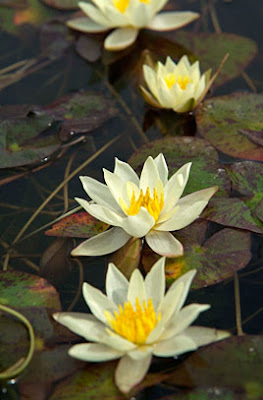The first thing to clarify is that the term lily is used to
cover the plants from at least three different families, although the most
recognized them by that name is that of the Nymphaeaceae, which are the most
used in gardening.
The lilies most recommended for cultivation in ponds are:
White water lily or Nymphaea alba: Also known as white
lotus, or water lily white nymph, is one of the most popular species and is
characterized by heart-shaped leaves and rounded, and because its white flowers
with many stamens can reach a size large (up to 30cm).
Mexican or Mexican Nymphaea Water Lily: It has flowers of a
strong yellow color and small leaves with different shades of green and tiny
spots.
Nymphaea Blue Beauty is a commercial tropical hybrid with
huge, fragrant starry flowers of a dark blue petals and sepals pale blue. This
plant is very sensitive to low temperatures.
Nymphaea Escarboucle: This lily is very resistant to frost
and can reach a maximum height of 10 cm. Its foliage is green during most of
the year and cups shaped flowers semi-double orange and red colors look dark in
the summer.
Nymphaea Pygmaea helvola:
It is a lily model with dark green rounded leaves with purple veins and
flowers cup-shaped fragrant yellow and sulfur than 5 centimeters in diameter,
with orange stamens. Although it has some resistance to cold, protection is
recommended during winter.
Other commercial species of water lilies that stand up well
to the onslaught of frost are the James Brydon, Rose Arey, Sunrise, Pygmaea
Rubra, Ambilis, Lucida, etc..
Cultivation and Care
The lilies grow easily in calm water and full sun, but often
require more care than other aquatic plants. It is advisable to grow water
lilies in pots with small holes all over its surface and fertilized soil
without elements that float easily and can get dirty pond water once the
emplace in the water.
When placed in the pond, care must be taken not to damage
the delicate roots because it can kill the plant.
Another thing to consider is that during the growing season
should be fed every certain period of time with a fertilizer water, because the
water lilies require large amounts of nutrients for their development.
To further stimulate blooms while avoiding contamination of
the pond (which can be fatal to these plants), it is advisable to remove the
dead flowers or are deteriorating, and prune the yellow leaves regularly.



















